Fluid Mechanics - PowerPoint PPT Presentation
Title:
Fluid Mechanics
Description:
Chapter 15 Fluid Mechanics Fluids Fluids (Ch. 5) substances that can flow (gases, liquids) Fluids conform with the boundaries of any container in which they are ... – PowerPoint PPT presentation
Number of Views:371
Avg rating:3.0/5.0
Title: Fluid Mechanics
1
Chapter 15 Fluid Mechanics
2
- Fluids
- Fluids (Ch. 5) substances that can flow
(gases, liquids) - Fluids conform with the boundaries of any
container in which they are placed - Fluids lack orderly long-range arrangement of
atoms and molecules they consist of - Fluids can be compressible and incompressible
3
- Density and pressure
- Density
- SI unit of density kg/m3
- Pressure (cf. Ch. 14)
- SI unit of pressure N/m2 Pa (pascal)
- Pressure is a scalar at a given point in a
fluid the measured force is the same in all
directions - For a uniform force on a flat area
4
- Atmospheric pressure
- Atmospheric pressure
- P0 1.00 atm 1.013 x 105 Pa
5
- Fluids at rest
- For a fluid at rest (static equilibrium) the
pressure is called hydrostatic - For a horizontal-base cylindrical water sample
in a container
6
- Fluids at rest
- The hydrostatic pressure at a point in a fluid
depends on the depth of that point but not on any
horizontal dimension of the fluid or its
container - Difference between an absolute pressure and an
atmospheric pressure is called the gauge pressure
7
Chapter 15 Problem 28
Barometric pressure in the eye of a hurricane is
0.91 atm (27.2 in. of mercury). How does the
level of the ocean surface under the eye compare
with the level under a distant fair-weather
region where the pressure is 1.0 atm?
8
- Measuring pressure
- Mercury barometer
- Open-tube manometer
9
- Pascals principle
- Pascals principle A change in the pressure
applied to an enclosed incompressible fluid is
transmitted undiminished to every portion of the
fluid and to the walls of its container - Hydraulic lever
- With a hydraulic lever, a given force applied
over a given distance can be transformed to a
greater force applied over a smaller distance
10
- Archimedes principle
- Buoyant force
- For imaginary void in a fluid
- p at the bottom gt p at the top
- Archimedes principle when a body is submerged
in a fluid, a buoyant force from the surrounding
fluid acts on the body. The force is directed
upward and has a magnitude equal to the weight of
the fluid that has been displaced by the body
11
- Archimedes principle
- Sinking
- Floating
- Apparent weight
- If the object is floating at the surface of a
fluid, the magnitude of the buoyant force (equal
to the weight of the fluid displaced by the body)
is equal to the magnitude of the gravitational
force on the body
12
Chapter 15 Problem 29
On land, the most massive concrete block you can
carry is 25 kg. Given concretes 2200-kg/m3
density, how massive a block could you carry
underwater?
13
- Motion of ideal fluids
- Flow of an ideal fluid
- Steady (laminar) the velocity of the moving
fluid at any fixed point does not change with
time (either in magnitude or direction) - Incompressible density is constant and uniform
- Nonviscous the fluid experiences no drag force
- Irrotational in this flow the test body will
not rotate about its center of mass
14
- Equation of continuity
- For a steady flow of an ideal fluid through a
tube with varying cross-section
Equation of continuity
15
- Bernoullis equation
- For a steady flow of an ideal fluid
- Kinetic energy
- Gravitational potential energy
- Internal (pressure) energy
16
- Bernoullis equation
- Total energy
17
Chapter 15 Problem 33
Water flows through a 2.5-cm-diameter pipe at 1.8
m/s. If the pipe narrows to 2.0-cm diameter,
whats the flow speed in the constriction?
18
Questions?
19
Answers to the even-numbered problems Chapter 15
Problem 16 10-14
20
Answers to the even-numbered problems Chapter 15
Problem 24 5.0 km
21
Answers to the even-numbered problems Chapter 15
Problem 36 (a) 1.9 m/s (b) 31 m/s































